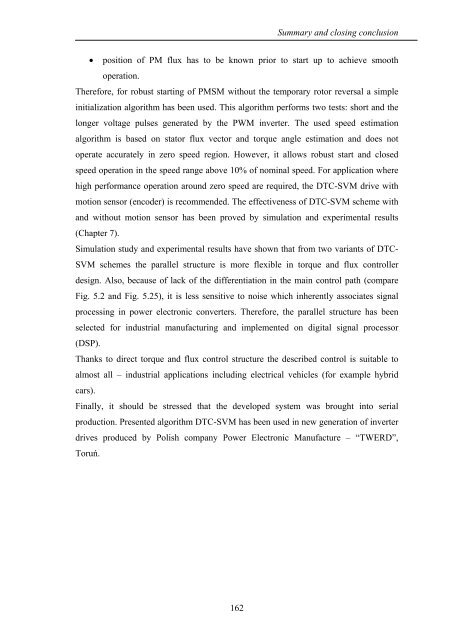Direct Torque Control with Space Vector Modulation (DTC-SVM) of ...
Direct Torque Control with Space Vector Modulation (DTC-SVM) of ...
Direct Torque Control with Space Vector Modulation (DTC-SVM) of ...
Create successful ePaper yourself
Turn your PDF publications into a flip-book with our unique Google optimized e-Paper software.
Summary and closing conclusion<br />
• position <strong>of</strong> PM flux has to be known prior to start up to achieve smooth<br />
operation.<br />
Therefore, for robust starting <strong>of</strong> PMSM <strong>with</strong>out the temporary rotor reversal a simple<br />
initialization algorithm has been used. This algorithm performs two tests: short and the<br />
longer voltage pulses generated by the PWM inverter. The used speed estimation<br />
algorithm is based on stator flux vector and torque angle estimation and does not<br />
operate accurately in zero speed region. However, it allows robust start and closed<br />
speed operation in the speed range above 10% <strong>of</strong> nominal speed. For application where<br />
high performance operation around zero speed are required, the <strong>DTC</strong>-<strong>SVM</strong> drive <strong>with</strong><br />
motion sensor (encoder) is recommended. The effectiveness <strong>of</strong> <strong>DTC</strong>-<strong>SVM</strong> scheme <strong>with</strong><br />
and <strong>with</strong>out motion sensor has been proved by simulation and experimental results<br />
(Chapter 7).<br />
Simulation study and experimental results have shown that from two variants <strong>of</strong> <strong>DTC</strong>-<br />
<strong>SVM</strong> schemes the parallel structure is more flexible in torque and flux controller<br />
design. Also, because <strong>of</strong> lack <strong>of</strong> the differentiation in the main control path (compare<br />
Fig. 5.2 and Fig. 5.25), it is less sensitive to noise which inherently associates signal<br />
processing in power electronic converters. Therefore, the parallel structure has been<br />
selected for industrial manufacturing and implemented on digital signal processor<br />
(DSP).<br />
Thanks to direct torque and flux control structure the described control is suitable to<br />
almost all – industrial applications including electrical vehicles (for example hybrid<br />
cars).<br />
Finally, it should be stressed that the developed system was brought into serial<br />
production. Presented algorithm <strong>DTC</strong>-<strong>SVM</strong> has been used in new generation <strong>of</strong> inverter<br />
drives produced by Polish company Power Electronic Manufacture – “TWERD”,<br />
Toruń.<br />
162















![[TCP] Opis układu - Instytut Sterowania i Elektroniki Przemysłowej ...](https://img.yumpu.com/23535443/1/184x260/tcp-opis-ukladu-instytut-sterowania-i-elektroniki-przemyslowej-.jpg?quality=85)
